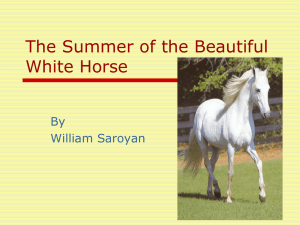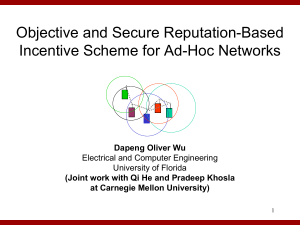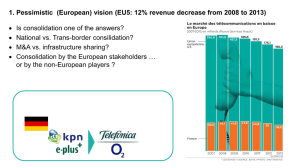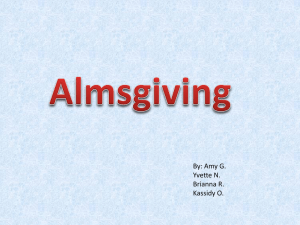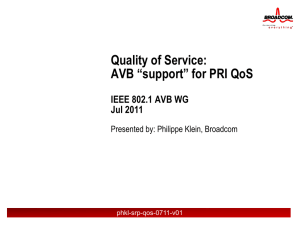Slides
advertisement
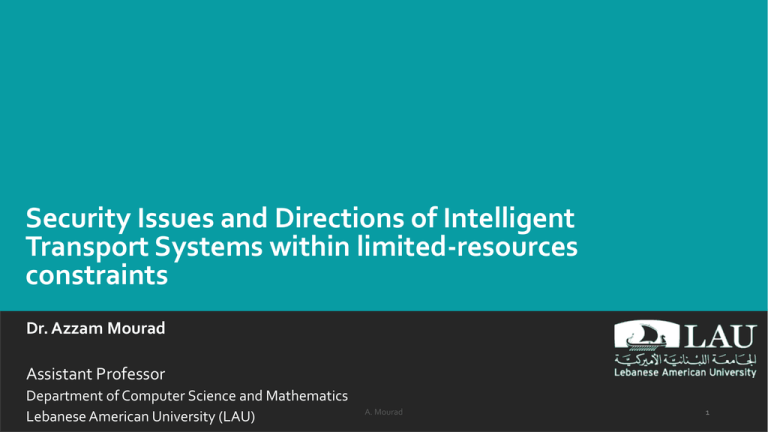
Security Issues and Directions of Intelligent
Transport Systems within limited-resources
constraints
Dr. Azzam Mourad
Assistant Professor
Department of Computer Science and Mathematics
Lebanese American University (LAU)
A. Mourad
1
Research Interest
•
•
•
•
•
•
Information Security
Security Hardening
Web Services Security
MANET/VANET Security
Trust in Web Services
Mobile Cloud
A. Mourad
2
Outline
Project Overview
• Security of Composite Services
•
•
•
•
AspectBPEL
SBA-XACML
Selfish Node Detection in VANET
•
•
Efficient Clustering Model
Cooperative Detection Model
A. Mourad
3
Intelligent Transport Systems
•
Contribute in solving several daily life problems
•
Control real-time traffic
Manage incident
Reduce the environment pollution
Reduce time Delay Reduce Financial Loss
Reduce Energy/Gaz Consumption
Boost the productivity and expand economic growth
Lack of ITS infrastructure in developing countries
o
o
Lead to lack of information for intelligent decisions
Need to provide alternative solutions based on
•
Multiple and diverse source of information
Avoiding the costly infrastructure sources
Interest of advanced country is in reducing the high cost of infrastructure
maintenance and upgrades
A. Mourad
4
Project Overview
•
Challenges
Services Composition
Adaptability and Cooperation
Context-awareness
QoS
Security, Trust and Privacy
Models and Algorithms for
Traffic Management and
Intelligent Decision Modules
A. Mourad
5
Partners and Collaborators
•
Lebanon
CNRS Lebanon
Lebanese American University (LAU)
Lebanese University
Private Sectors
•
France
•
LIMOS
Canada
Concordia University
ETS Montreal
•
UAE
•
Khalifa University
Looking for other international partners
A. Mourad
6
Outline
Project Overview
• Security of Composite Services
•
•
•
•
AspectBPEL
SBA-XACML
Selfish Node Detection in VANET
•
•
Efficient Clustering Model
Cooperative Detection Model
A. Mourad
7
Introduction
Motivations
WSs are emerging as convenient
mechanism for automated
interaction between distributed
applications
A. Mourad
8
Introduction
Motivations
Web Service
Nevertheless, the successful deployment of this technology cannot hide the security breaches
and threats that Web services can be exposed to.
A. Mourad
9
Introduction
Motivations
Web Service
SAML
WS-Security
…
SAML , WS-Security and other standard security languages emerged to offer messagelevel security for web services.
A. Mourad
10
Introduction
Motivations
Web Service
SAML
WS-Security
…
Web Service
Web Service
However, the problem arises when several distributed and/or independent Web services are
composed together in a process to form a complex system.
A. Mourad
11
BPEL Example: Weather Forecast Process
1- SOAP Request:
GetActivity/Weather
Parameter : 12345
2- SOAP Request: GetWeatherInfo, Parameter : 12345
3- SOAP Response : Rainy
4- SOAP Request: Rainy
6- SOAP Response: Shopping
Web Service
Web Service
5- SOAP Response: Shopping
A. Mourad
12
BPEL Example: WS-Security
<soap:Envelope
<soap:Header>
1- Where<wsse:Security>
can I find a weather forecast service?
<xenc:EncryptionMethod Algorithm =
2- There
is
a “Weather Service” in Server B
"http://www.w3.org/2001/04/xmlenc#tripledes-cbc"
/>
</wsse:Security>
</soap:Header>
<soap:Body>
<xenc:CipherData>
<xenc:CipherValue
> InmSSXQcBV5UiT
</xenc:CipherValue>
3- How exactly
should I invoke
you?
</xenc:CipherData>
</soap:Body>
4- Take
a look at this WSDL
</soap:Envelope>
UDDI
Web Service
5- WSS SOAP Request
6- SOAP Response: Rainy
A. Mourad
13
Problem 1
SAML
Performance Issue !
WSS
…
Need for centralization !
SAML
WSS
…
SAML
WSS
…
BPEL is only given the
responsibility of business modeling.
Message-level security at each
individual web service.
A. Mourad
14
Problem 1
Possible solution may be to harden the security of a BPEL process
to embed the security verification code within the business logic of
such process.
With the use of the current BPEL:
• There is a lack of modularity for modeling cross-cutting concerns :
Security, Logging, monitoring, etc…
• No support at the process deployment level for changing the
composition at run time. Thus, deactivation of the process upon
modification.
• Centralization of security at the web service side, which causes a lot of
overhead.
A. Mourad
15
Problem 2
Another more dynamic approaches may be to enforce security
through policy languages like WSPL and XACML.
XACML
A. Mourad
16
Problem2
•
Large and complex policies lead to slower access request/response
time.
•
Specifying security policies using these languages is difficult, error-prone
and time consuming.
•
Hidden conflicts that may arise due to the diversity of roles in policies that
are difficult to locate and resolve.
•
No verification processes to ensure policy correctness
Difficult to analyze and detect flawed policies due to complex structure.
• Multiple XACML party integration is very difficult.
•
•
Usually they are enforced at the WS level
A. Mourad
17
1- AspectBPEL: Dynamic Weaving based on
Aspect-Oriented Programming
Pointcut
…
Join Point
f ();
pointcut P = call (“% f(…)”);
...
Original Code
Advice
Weaver
advice P : before () {
code1;
code2;
}
advice P: after () {
code3;
code4;
}
...
code1;
code2;
f();
code3;
code4;
...
Aspect
A. Mourad
Weaved Code
18
1- AspectBPEL: Dynamic Weaving based on
Aspect-Oriented Programming
A. Mourad
19
1- AspectBPEL Limitations
AspectBPEL can solve the modularity and the security problems in the Web
services composition but…
Adaptability
Complex Policies
Conflict
Moreover, the work in which AspectBPEL is presented does not provide
any methodology for verification before and after weaving
Correctness
Deadlock-Free
A. Mourad
Original Behavior Maintainability
20
1- Extended AspectBPEL
Aspect aspect_name //Begin a New Aspect
Priority priority_value
BeginAspect
Before | After | Replace //Insertion Point
Variable1 operator variable1_value connector Variable2 operator variable2_value …
Activity_Type <activity_name> //Location Identifier
Activation_Condition activation_condition_value
BeginBehavior
....Behaviorcode //Code to Add
EndBehavior
EndAspect
A. Mourad
21
1- Extended AspectBPEL
A. Mourad
22
1- Case Study
A. Mourad
23
1- Case Study
A. Mourad
24
1- Case Study
A. Mourad
25
1- Case Study
Authentication “After” “receiveInput”
Only Authenticated users can get access to TBS services
Just in case the user books a complete package, the Discount will be applied
Encryption precedes Logging
Discount, Encryption and Logging
“Before” “Assign Payment Info To BWS”
A. Mourad
26
1- Formal Verification Mechanism on BPEL
BPEL
Process
BPEL2OWFN
Tool
PNML
File
TINA
Tool
Ktz
File
Original Behavior
Maintainability
LTL
Property
Result
Deadlock-Free
Correctness
A. Mourad
27
1- Formal Verification Mechanism on BPEL
A. Mourad
28
1- Formal Verification Mechanism on BPEL
Table-1 Original Functionalities Maintainability Verification
Table-2 Deadlock-Free Verification
Table-3 Correctness Verification
In the next state |
Always in the future |
Eventually |
A. Mourad
Alternative of OR |
Logical implication
29
2- SBA-XACML Evaluation and Analysis
SBA-XACML
Language
XACML
Request
SBA-XACML
Compiler
SBA-XACML
Request
XACML
PolicySet
SBA-XACML
PolicySet
Policy Analysis
Module
Policy Evaluation
Module
Response
A. Mourad
Analysis
Report 30
2- SBA-XACML Syntax
•
A PolicySet (PS) is the top element of the based
policy and is mapped to set-based as:
Element
Definition
PS
PolicySet
ID
PolicySet ID
SP
Set of Policies
PR
Precedence order between policies
PCA
Policy Combining Algorithm
IPS
Policy reference
OBLs
Set of Obligations
TR
Target
A. Mourad
31
2- SBA-XACML Syntax
•
A Policy (P) is the middle element of the based
policy and is mapped to set-based as:
Element
Definition
P
Policy Type
ID
Policy ID
SR
Set of Rules
PR
Precedence order between rules
RCA
Rule Combining Algorithm
OBLs
Set of Obligations
TR
Policy Target
A. Mourad
32
2- SBA-XACML Syntax
•
A Rule (R) is the bottom element of the based
policy and is mapped to set-based as:
Element
Definition
R
Type: Rule
ID
Rule ID
RC
Rule Conditions
TR
Rule Target
RE
Rule Effect
A. Mourad
33
2- SBA-XACML Syntax
•
A Request (Rq) is mapped to set-based as:
Element
Definition
Rq
Type: Request
Sr
Request Subjects
Rr
Request Resources
Ar
Request Actions
A. Mourad
34
2- XACML to SBA-XACML
A. Mourad
2- XACML to SBA-XACML
XACML Request:
SBA-XACML Request:
A. Mourad
36
2- SBA-XACML Evaluation
Semantics (27 rules)
A. Mourad
37
2- Experimental Results
@1600 rules
Avg. per 100k
Run
Sun PDP
143 ms
XEngine
109 ms
SBA-XACML
31.62 ms
SBA-XACML is 4.5 and 3.4 times more efficient
than Sun PDP and XEngine respectively.
Synthetic Policy Evaluation
@298 rules
Avg. per 100k Run
Sun PDP
60 ms
XEngine
23 ms
SBA-XACML
8 ms
SBA-XACML is 7.5 and 2.8 times more efficient
than Sun PDP and XEngine respectively.
A. Mourad
Real Policy Evaluation
38
2- Flaws Detection Semantics
Flaws, Conflicts and Redundancy Detection
(4)
(3)
(2)
(1)
A. Mourad
39
2- Flaws Detection Semantics
Case Study
PolicySet : PS1
Policy:P1
Rule:R1
Policy:P2
Rule:R3
Rule:R4
Target (TR1):
any subject
any resource
any action
Target (TR3):
any subject
any resource
any action
Target (TR4):
any subject
any resource
any action
Rule condition (RC1):
Resource = withdraw
Rule condition (RC3):
Resource = deposit
Rule condition (RC4):
Resource = deposit &
Subject = Joe
Rule effect (RE1):
permit
Rule effect (RE3):
A. Mourad
permit
Rule effect (RE4):
permit
40
2- Flaws Detection Semantics
Case Study
A. Mourad
41
Outline
Project Overview
• Security of Composite Services
•
•
•
•
AspectBPEL
SBA-XACML
Selfish Node Detection in VANET
•
•
Efficient Clustering Model
Cooperative Detection Model
A. Mourad
42
Problem
o Clustering & Routing
o Mobility-based clustering algorithms such as DMAC and APROVE
focus on direction and speed to group vehicles.
•
o
•
o
However, mobility-based algorithms ignore the QoS metrics
QoS-based clustering algorithms such as QOLSR and QoS-OLSR focus on
bandwidth and energy to group vehicles.
The QoS-based algorithms ignore the mobility constraints
Security
o
•
In reputation-based schemes, nodes monitor, detect, and then
declare another node to be misbehaving. This announcement is then
broadcasted all over the network, leading to discard the
misbehaving node from being used in all future routes.
Limitations: ambiguous collision, false alarms, and non-cooperative decision
A. Mourad
43
Notations
Cluster 1
Cluster 2
5
11
77
3
12 12
1
2
1
4
MPR
CH-2
1313
8 8
9
Cluster-head
A. Mourad
10
14
11
Normal Node
44
Approach
o VANET QoS-OLSR:
Extend the network lifetime while maintaining the Quality of Service
o Reduce the communications overhead
o Prevent the cheating during elections
o
o VANET-DSD:
Motivate the cooperation
o Detect the selfish/misbehaving vehicles after elections
o
A. Mourad
45
VANET QoS-OLSR
QoS Model
Cluster-heads election
MPR nodes Selection
A. Mourad
46
QoS Model
QoS(i) = BW(i) x N(i) x DistRatio(i)/VelRatio(i)
Symbol
Significance
i
A node in the network
QoS(i)
Quality of Service Metric of node i
BW(i)
Available bandwidth of i
N(i)
Neighbors of i
ResidualDistance(i)
ResidualDistance(i)= MaximumDistance-CurrentPosition(i)
DistRatio(i)
(ResidualDistance(i)/MaximumDistance)
AvgSpeed
AvgSpeed= Total distance/Total time = 2D/(t1 + t2).
VelRatio(i)
Velocity (i)/AvgSpeed
A. Mourad
47
QoS Model
QoS= Bandwidth x Connectivity x Distance/velocity
• Propotional relation with the bandwidth:
•
more reliability
•
Propotional relation with the connectivity:
less percentage of MPRs & overhead
•
Propotional relation with the distance:
more stability
•
Inversely proportional relation with the velocity:
more & more stability
A. Mourad
48
Cluster-Heads Election
I am the clusterhead
QoS=500
QoS=300
Ack message
QoS=300
QoS=200
QoS=100
QoS=500
Ack message
QoS=800
I am the clusterhead
A. Mourad
49
MPRs Selection
Route Time(1)= 10
Route Time(2)= 10
Node 8
Phermone(1)=480-10=470
5
Node 6
QoS=280
ant1
6
3
QoS=300
12
1
ant2
2
4
11
Encrypt QoS
ant1-1
QoS=200
1
88
Decrypt QoS
CH-2
13
10
ant2-1
1 Encrypt QoS
Phermone(2)=500-10=490
MPR Node
Node 1
8
Cluster-head Node
14
11
Normal Node
Phermone(i)=QoS(i)-Route Time(i)
A. Mourad
50
Factors to Evaluate
o
Percentage MPRs: The number of elected MPR nodes.
o
Percentage of stability: current number of nodes in each cluster divided by the previous
number of nodes in it
o
End-to-End delay: the average number of hops needed to transfer data between the
source and the destination
o
Packet Delivery Ratio: # of received packets/ # of sent packets by the source.
o
Bandwidth Average Difference: it is the bandwidth difference between the path
having the maximal bandwidth value and the path currently selected.
A. Mourad
51
Simulation Area
A simulation area of 3000 x 1000 m
A. Mourad
52
Simulation Parameters
A. Mourad
53
Simulation Results
Average
Packet
Delivery
Number
Ratio
Of
Hops
Percentage
ofof MPRs
stability
Percentage
5.5
60
80
1
VANET QoS-OLSR
QoS-OLSR
Classical QOLSR
5
0.9
75
50
4.5
0.8
70
4
40
3.5
0.7
65
3
30
0.6
60
2.5
VANET QoS-OLSR
QoS-OLSR
Classical QOLSR
VANET QoS-OLSR
VANET QoS-OLSR
QoS-OLSR
QoS-OLSR
Classical QOLSRClassical QOLSR
2
0.5
55
20
1.5
0.4
50
1
10
0.3
45
0.5
0
0.2
4030
30
40
40
50
50
60
60
70
70
Number Of Nodes
Number
Number Of
Of Nodes
Nodes
A. Mourad
80
80
90
90
100
100
54
Selfish/Misbehaing Nodes Problem
o Will the vehicles follow this protocol or not?
o Questions on mind:
o
Why should I pay time & resources serving as MPR for nothing?
o
What is the return?
A. Mourad
55
Definition of Selfish Nodes
o Selfish nodes in VANET are rational nodes
that prefer to over-speed or under-speed on
the road instead of spending their resources
and time without receiving return.
o Types of selfish nodes
During elections
After elections
A. Mourad
56
Impact of Selfish Nodes
1003
Percentage
of
Percentage
of stability
MPRs
Average
Number
Of Hops
90
2.8
80
70
2.6
0%0%
selfish
nodesnodes
selfish
20% selfish nodes
20% selfish nodes
30% selfish nodes
30%
selfish
40%
selfish
nodesnodes
40%
selfish
50%
selfish
nodesnodes
0% selfish nodes
20% selfish nodes
30% selfish nodes
40% selfish nodes
50% selfish nodes
50% selfish nodes
60
50
2.4
40
2.2
30
20
2
10
0
1.8
30
30
40
40
50
50
50
60
60
60
70
70
70
Number
Number
Of
Nodes
NumberOf
OfNodes
Nodes
A. Mourad
80
80
80
90
90
90
100
100
100
57
VANET- DSD: Cooperative Detection Model
Payment & Reputation
Network Services Distribution
Detection Mechanism
A. Mourad
58
Payment and Reputation
Payment(12)= QoS(12)-QoS(1)=500-460=40
3
Payment(8)= QoS(13)-QoS(8)=510-450=60
5
QoS=300
QoS=500
66
QoS=400
77
QoS=460
12 12
QoS=450
1 1
2
QoS=510
CH-2
13
13
13
8 8
4
9
Reputation(12)=Reputation(12)+Payment(12)=100+40=140
MPR
11
7
10
1114
Reputation(1)=Reputation(1)+Payment(1)=100+60=160
Cluster-head
A. Mourad
Normal Node
59
Reputation and Network Service Distribution
Available bandwidth=1000 Mb/s
Reputation=109
Reputation=130
1
2
Reputation=116
3
Total Reputation=109+130+116=355
Reputation Ratio=109/355
1
Reputation Ratio=130/355
2
BW share=109/355x1000
1
BW share=130/355x1000
2
A. Mourad
Reputation Ratio=116/355
3
BW share=116/355x1000
3
60
Detection Mechanism
Watchdogs Monitoring
Sharing
Aggregation
Information Dissemination
A. Mourad
61
Monitoring
Cluster 1
Cluster 2
5
Overhear
3
7
6
2
12
Packet P1
1 1
8 8
11
7
10
CH-2
13
14
11
4
9
MPR
Watchdog
Cluster-head
A. Mourad
Normal Node
62
Sharing
Cluster 1
1 is cooperative
1 is cooperative
5
3
1 is selfish
2
Cluster 2
1 is cooperative
1 is cooperative
6
12
4
7
1 1
8 8
11
7
10
CH-2
14
11
13
1 is cooperative
9
MPR
Watchdog
Cluster-head
A. Mourad
Normal Node
63
Aggregation – Why Dempster-Shafer
o The usefulness of Dempster–Shafer in representing and combining different types of
evidences coming from independent sources
o The fact that Dempster–Shafer represents uncertain evidences, which makes it appealing to
model the ambiguity in the detection caused by the high mobility of vehicles and the channel
collisions
o The good reputation of Dempster–Shafer in many critical fields like investigating crimes and
diseases.
A. Mourad
64
Aggregation Example
•
Watchdog A (reputation = 0.9):
•
•
•
•
m1(C) = 0.9 (Vehicle 1 is cooperative)
m1(U) = 0.1 (watchdog 1 is uncertain)
m1(S) = 0 (M is selfish)
Watchdog B (reputation = 0.8):
•
m2(C) = 0 (Vehicle 1 is cooperative)
•
m2(U) = 0.2 (Vehicle 1 is selfish)
m2(S) = 0.8 (watchdog 2 is uncertain)
•
A. Mourad
65
Information Dissemination
Cluster 1
Cluster 2
5
3
7
6
1 is cooperative
2
12
11
7
10
1 is cooperative
1 1
8 8
CH-2
13
14
11
4
9
MPR
Watchdog
Cluster-head
A. Mourad
Normal Node
66
Simulation Results
A. Mourad
67
Related Publications
•
•
•
•
•
•
•
•
•
A Cooperative Watchdog model based on Dempster-Shafer for Detecting Misbehaving Vehicles. Accepted
in the Journal of Computer Communications, 2014, Elsevier
A Dempster-Shafer based Tit-for-Tat Strategy to Regulate the Cooperation in VANET using QoS-OLSR
Protocol. Accepted in the Journal of Wireless Personal Communications, 2013, Springer
Reputation-Based Cooperative Detection Model of Selfish Nodes in Cluster-based QoS-OLSR Protocol.
Accepted in the Journal of Wireless Personal Communications, 2013, Springer
XrML-RBLicensing Approach Adopted to the BPEL process of Composite Web services. In the Journal of
Service Oriented Computing, 7(3): 217-230, 2013, Springe
Common Weaving Approach in Mainstream languages for Software Security Hardening. In the Journal of
Systems and Software, 86(10): 2654-2674, 2013, Elsevier
New XACML-AspectBPEL Approach for Composite Web Services Security. In the International Journal of
Web and Grid Services, 9(2): 127-145, 2013, Inderscience
Vanet-QOLSR: QoS-based Clustering OLSR Protocol for Vehicular Ad hoc Networks. In the Journal of
Computer Communications, 36(13): 1422-1435, 2013, Elsevier
A Novel Aspect-Oriented BPEL Framework for the Dynamic Enforcement of Web Services Security. In the
International Journal of Web and Grid Services, 8(4): 361–385, 2012, Inderscience
A synergy Between Context-Aware and AOP to Achieve Highly Adaptable Web Services. In the Journal of
Mourad
68
Service Oriented Computing, 6(4): 379-392, 2012,A.Springer
Questions?
Thank You…
A. Mourad
69
